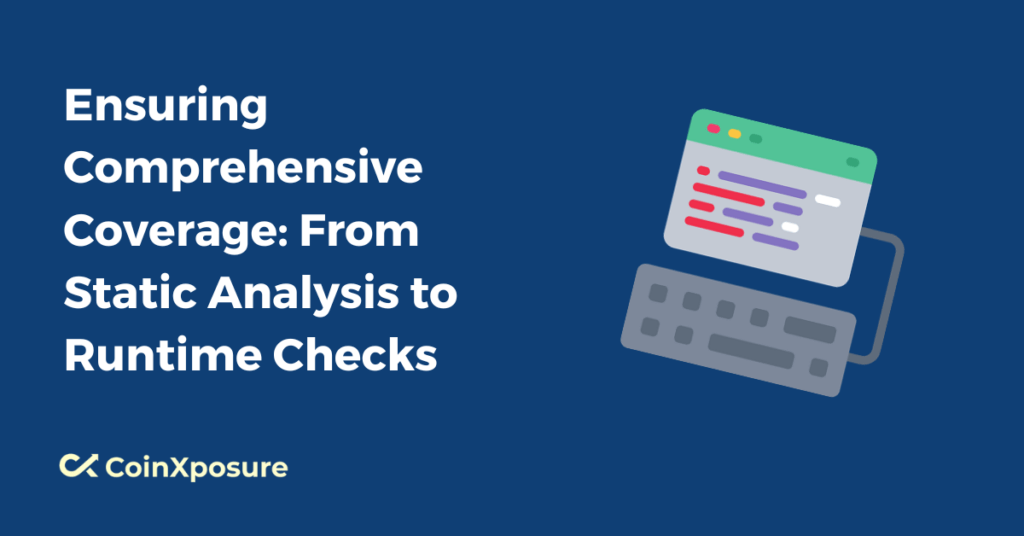In the dynamic landscape of software development, ensuring comprehensive coverage is paramount for delivering robust and reliable applications.
From the earliest stages of static analysis to the ongoing checks at runtime, a thorough approach is essential to identify and rectify potential issues.
This article explores the integration of static analysis and runtime checks, emphasizing their combined role in fortifying software against vulnerabilities and enhancing overall code quality.
Static Analysis
Static analysis is a critical phase in software development that involves examining the source code without executing the program. It aims to identify potential issues, such as coding errors, security vulnerabilities, and adherence to coding standards.
This analysis is typically performed through automated tools and manual code reviews, providing developers with insights into the code’s structure and potential pitfalls before runtime.
While static analysis offers valuable early detection of issues, it is essential to recognize its limitations and complement it with dynamic analysis for a more comprehensive approach to ensuring software reliability and security.
Dynamic Analysis
Dynamic analysis is a pivotal component of software testing that involves evaluating a program’s behavior during execution. Unlike static analysis, which examines the source code without running the program, dynamic analysis requires the actual execution of the software.
Techniques include unit testing, integration testing, and system testing, among others. By monitoring variables, memory usage, and interactions with external components, dynamic analysis helps identify runtime errors, performance bottlenecks, and unexpected behaviors.
Combining dynamic analysis with static analysis forms a holistic strategy for comprehensive code evaluation, ensuring that software not only meets functional requirements but also performs reliably in real-world scenarios.
Bridging the Gap: Combining Static and Dynamic Analysis
Bridging the gap between static and dynamic analysis is imperative for a thorough software evaluation. Integrating these complementary approaches enhances the overall effectiveness of the development process.
By combining static analysis, which scrutinizes the code before execution, with dynamic analysis, which assesses the program’s behavior during runtime, developers can achieve a more comprehensive understanding of potential issues.
This integration helps address the limitations of each method, reducing false positives and negatives. Striking a balance between static and dynamic analysis contributes to improved code quality, better error detection, and a more resilient and reliable software product.
Continuous Monitoring and Feedback
Continuous monitoring and feedback are essential elements in the software development lifecycle, ensuring ongoing improvements and robustness. Real-time monitoring allows developers to track the performance and security of applications as they evolve.
Automated feedback mechanisms, integrated into the development pipeline, provide instant insights into potential issues, allowing for prompt corrective actions.
By establishing a continuous feedback loop, development teams can identify and address vulnerabilities, performance bottlenecks, and other issues throughout the development process.
This iterative approach fosters agility, accelerates problem resolution, and enhances the overall quality of the software. Embracing continuous monitoring and feedback aligns with the principles of DevOps, promoting a seamless integration of development and operations for a more efficient and resilient software delivery pipeline.
Future Trends and Technologies
In the ever-evolving landscape of software development, several future trends and technologies are shaping the way we approach coding, testing, and deployment:
- Shift Toward Automation
- DevSecOps Integration
- Microservices Architecture
- Serverless Computing
- Edge Computing
- Increased Containerization
Shift Toward Automation
- Increased automation in testing, deployment, and monitoring processes.
- Integration of artificial intelligence and machine learning to automate repetitive tasks and enhance decision-making.
DevSecOps Integration
- Greater emphasis on security throughout the development lifecycle with the integration of security practices into DevOps (DevSecOps).
- Automated security testing tools and practices becoming more prevalent.
Microservices Architecture
- Continued adoption of microservices architecture for building scalable and modular applications.
- Tools and frameworks evolving to support the complexities of microservices development.
Serverless Computing
- Growing popularity of serverless computing for efficient resource utilization and scalability.
- Focus on event-driven architecture and pay-as-you-go models.
Edge Computing
- Rise of edge computing for processing data closer to the source, reducing latency.
- Challenges and innovations in managing distributed systems at the edge.
Increased Containerization
- Widespread use of containerization technologies like Docker and Kubernetes for simplified deployment and scalability.
- Container orchestration tools evolving to meet complex application demands.
As technology advances, staying abreast of these trends and adapting development practices accordingly will be crucial for building resilient, efficient, and secure software solutions.
Conclusion
The journey from static analysis to runtime checks underscores the importance of a comprehensive approach to software development. Integrating static and dynamic analysis methods allows for a nuanced understanding of code quality, security, and performance.
Continuous monitoring and feedback mechanisms further enhance the development process, enabling swift responses to evolving challenges.
Looking ahead, future trends and technologies signal a shift towards greater automation, increased security integration, and the adoption of innovative architectures. Embracing these changes will be pivotal for staying competitive and delivering software that not only meets current standards but also anticipates the evolving needs of users and industries.
As the software development landscape continues to evolve, the commitment to quality, security, and adaptability remains paramount.
By embracing a holistic perspective that combines analytical rigor, continuous improvement, and a forward-looking mindset, developers can navigate the complexities of modern software development successfully.
Ultimately, ensuring comprehensive coverage is not just a development practice but a strategic imperative in a world where technology is at the heart of progress.
